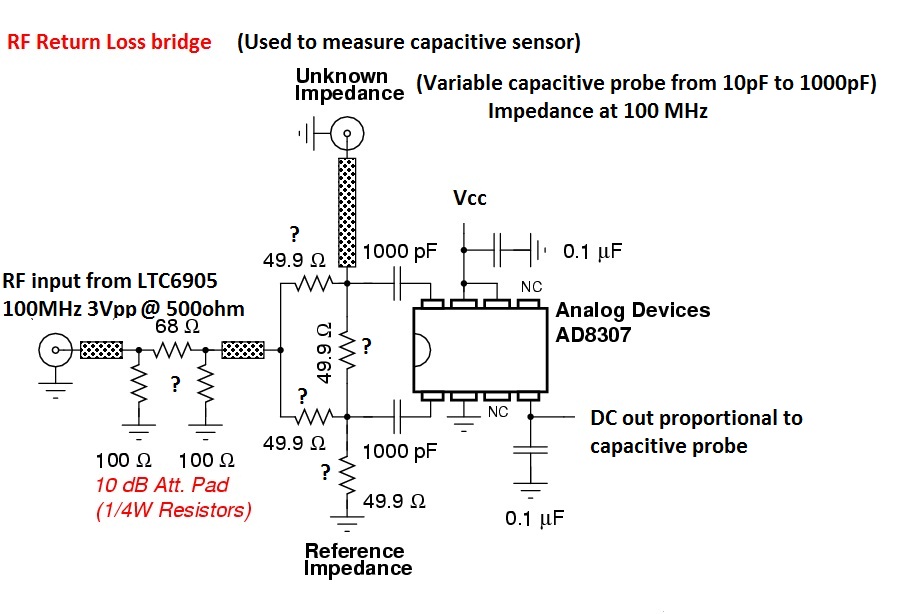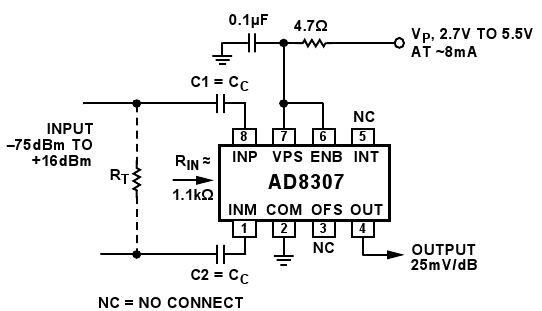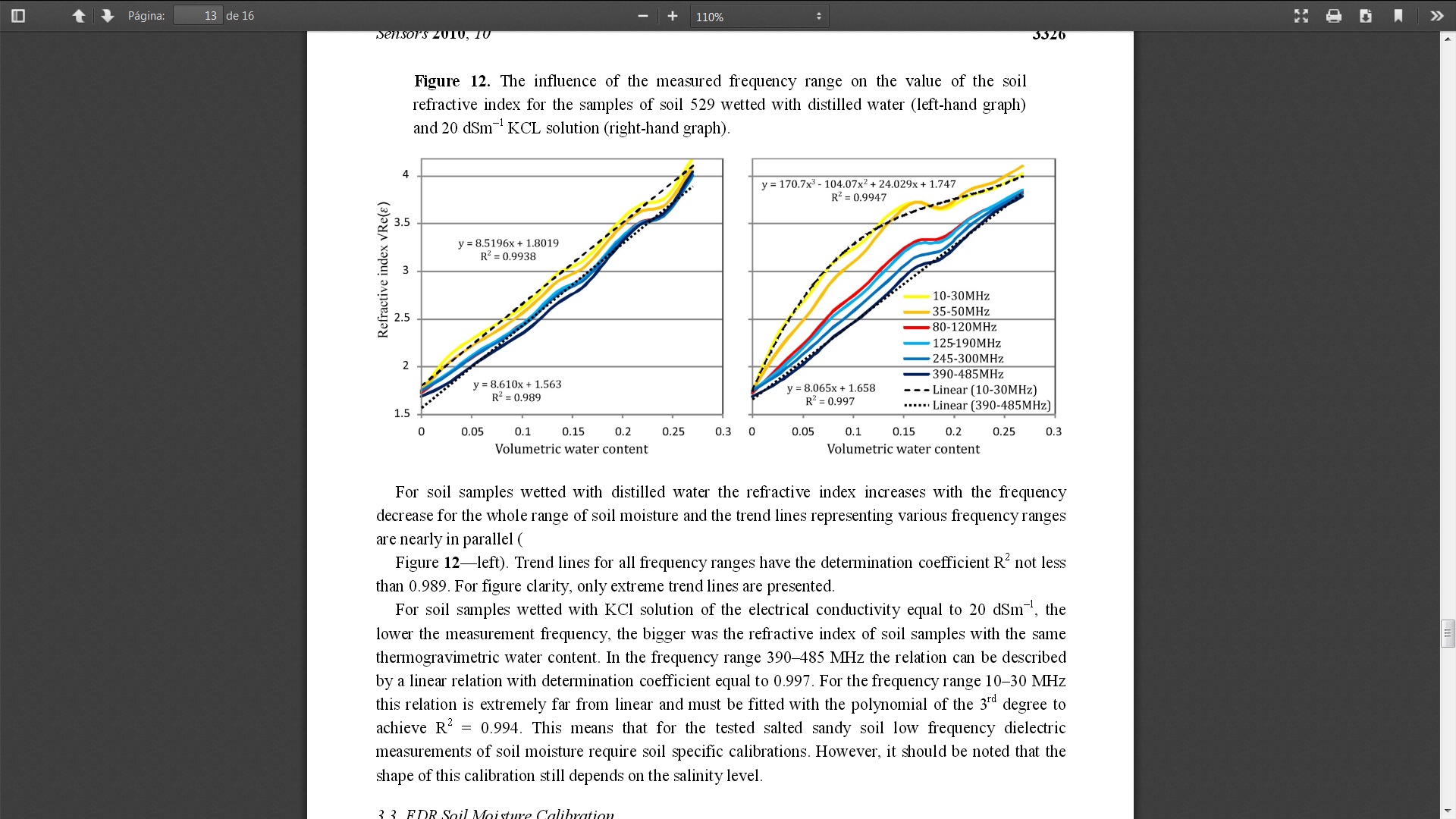Re: Use RF 100MHz to measure soil moisture IC generator plus IC detector
Are you watering it with pure distilled water?
If the above is false then simple AC resistance measurement of the soil will show if it is damp or dry.
Sir, this is a development for open source soil sensor, should be compactible with all soils, but should measure only water content and not water content plus minerals.
The diference sensor 100MHz to 1MHz for example is that at 1MHz all signal is reflected by minerals in water. So you will be measuring water plus minerals, not only water content. If you go to 100MHz minerals does not affect measure, minerals have RF transparency at 100MHz. Precise measure only water content.
Hi, my ideia is to have a variable capacitive sensor on variable surrounding dielectic. But operating at RF 100MHz and measuring returned losses to get output DC. The capacitive probe will have from 10pF dry to 1000pF in wet dielectric.
The circuit ideia is this on ths picture:
The detector will measure return losses from this capacitive probe on media. (The ideia is to have RSSI variation proportional to dielectric changing air equal 1, soil =20 to 100 )
I found IC AD8307 good to measure RSSI signal to DC output. Here is a return loss circuit (only the ideia, must be redesigned).

This is simplify return loss circuit:

Impedance matching network is not very easy. But I'm going to use LTC6905 oscillator at 100MHz at input and output is going to capacitive probe (variable from 10pF to 1000pF) But now all matching network needs to be changed. Can someone help me?
The LT6905 ouputs 3Vpp 100MHz at 500ohm load . Will be this too much voltage?
Here are probes I tested with capacimeter. One of them was developed by me using zigbee outputing 4MHz to measure probe capacitance.
But now need 100MHz for some specific aplication.

Hi, check the new technical document from the capacitive soil sensor.
The link is this one. This one is updated.
My RF soil probe prototype is working fine. Please check https://db.tt/oqoKNU2R
FDR soil sensor working. Probe range is 15cm to detect hand, few mV change. wet soil to dry voltage difference 300mV
Measuring soil volumetric water content 15cm radius. Using 80MHz
Salinity insensible.
Need to amplify this voltage output to get range 0-3V proportional out
AD8307 outputs 3V dry and 2,7V at wet soil (reflectivity of soil). Need to use ampop subtractor with gain and a voltage referece. to get output proportional 0-3V
Probably you are seeing RF absorption. You can use the same ideas like in light absorption.
Yes absorption/reflection. For light there is an examle ir ligh sensors with emitteur and receiver ir led's.
Paralell pcb plates act as small antena cylindrical pattern. It starts detecting hand reflection at 15cm. Maybe a 15cm antenna range..

Inside soil it measures moisture. Soil wet output ad8307 2,7V , soil dry output 3,0V interval 300mV between dry and wet soil.
I'm using tantalum capacitors so maybe some lost at 80MHz, with ceramic less imepdance.
There is also a soil sensor with detecting rance

Styrofoam beads are plastic- made from polystyrene- they are not naturally expected to be present in soil.They cannot be called salts or minerals.
Water salinity influence measures at low frequencuies. See this paper.

Most linear to measure and transparent to minerals is 380-485MHz range
It is unlikely to be reflection because at 100MHz, the wavelength is about 30cm and a bare hand will not be able to reflect any significant amount.
However, absorption remains the possibility. Presence of the hand nearby will load the antenna and this will be seen as greater dielectric absorption...
True, but what the authors in the paper are reporting is the real part of the dielectric constant (lossy part) and happily ignoring the imaginary part of the dielectric constant.
The DC dielectric constant can be much different from the AC dielectric constant. Also note that the refractive index relation with the dielectric constant near some absorption band is often anomalous.
I agree that the quoted diagram emphasizes the importance of a complex impedance measurement. But the real part of ε is not the "lossy part", it's the imaginary part of permittivity that represent the losses https://en.wikipedia.org/wiki/Permit...x_permittivity
Unfortunately, the presented impedance measurement method doesn't selectively measure real and imaginary impedance components, just a scalar reflection factor.
Hi, for new design I recommend this setup.
This will adjust better range because AD8307 is logarithmic. So find better range for probe on wet and probe dry. Adjust R until get most difference between wet to dry probe voltage output.
If you do not want 100MHz or 80MHz you can use any oscillator. I tested at 100khz with 2cm range. But not transparent to minerals.Good results only for tap water no nutrients added. 400ppm
Regards,
Vitor
Yes, this looks like a simple, basic method for experimenting.
Data reflects the raw concept used in measuring it.
Hello , I want to ask how you are satisfied with the measurement of soil moisture ? it does not raise the temperature dependence ? Thank you
I guess it simply measures the impedance and converts the result to moisture content...
